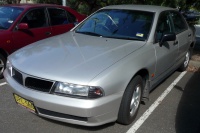Difference between revisions of "TE"
Cartman02au (talk | contribs) |
|||
| Line 1: | Line 1: | ||
{{Infobox_twomodel | | {{Infobox_twomodel | | ||
| − | image=Image | + | image=[[Image:TE_Magna.jpg|center|200px]]| |
model=TE| | model=TE| | ||
magna_verada=Verada Equivalent: | | magna_verada=Verada Equivalent: | | ||
Revision as of 10:45, 3 September 2011
| TE | ||||||||||||||||
|
The TE was the first Magna of the Third Generation and was a massive step forward from previous models. In addition to being a completely new body, the TE also introduced new engines and transmissions.
The Astron II was retired, being replaced with a "Sirius" 2.4 Litre 16 valve single overhead camshaft unit. The Sirius was hailed as being smoother, quieter and more powerful than the Astron II (despite having less torque). The V6 did not go untouched either, a 24 valve single overhead cam version of the much liked 6G72 was the V6 in the TE.
Unfortunately, the 4 cylinder models did not sell all that well, most likely due to the fact that there was only $750 difference between the 4 cylinder and V6. Both engines with automatic transmission were more fuel efficent than the 2.6 Astron in Manual form. The V6 using 6-7 litres per 100km on highway runs and 11.0 in city runs using standard exhaust, etc.
The engines were also mounted on the left hand side for the first time so that they rotated in the same direction as the front wheels. This meant that the transaxles no longer needed to reverse the rotation before putting the power to the ground. This also meant that new transmissions were required.
The new transmissions were mechanically simpler than their predecessors. Both now used a two shaft design (instead of three in the previous series) and no longer required that the torque be reversed before output. The manual also received a new flywheel incorporating a flexible plate to reduce vibration, whereas the automatic received the advanced INVECS II logic system.
The body of the TE is said to be of the "pillared hardtop" style. It has steep front and rear windows, frameless door glass, slim 'B' pillar and sweeping roof. The body of the TE is extremely aerodynamic (something Mitsubishi had required in the TE's design bref). The TE was often commented on as being sporty in appearance due to it's styling and flared wheel guards.
The body of the TE was also said to be stiffer than the Second Generation Magna and was insulated heavily against noise and vibration. Though not silent, interior noise levels are exceptionally quiet along with comfotable and supportive seating. Engine vibration is hardly noticable. The TE Magna is a very quiet car to ride in.
The suspension of the TE was also improved, with the sedan gaining independent rear suspension (via a multi-link system) for the first time. Wagons carried over the basic rear suspension from the TS, but also added an anti-roll bar.
The wagon did not debut at launch (like both previous generations) and was made available a year later.
Equipment/Trim Levels
Executive
The executive featured remote central locking with immobiliser, power steering, immobiliser, electric mirrors and a security coded 4 speaker radio cassette as standard. Options included metallic paint, air conditioning, alloy wheels, cruise control, ABS, drivers only airbag and dual front airbags.
The Executive was available in both 4 cylinder and V6 models with manual or automatic transmissions. About 70% are V6.
Altera
Featured everything the Executive had but also made electric windows, cruise control, metallic paint, electric antenna and air conditioning standard. The options available were CD player, ABS, drivers only or dual front airbags and alloy wheels.
The Altera was available in 4 cylinder and V6 models. Manual transmissions were available for the 4 cylinder only with automatic transmissions optional on the Altera 4 cylinder and standard on the V6. 4 cylinder models are extremley rare on the Altera, most which are manual.
Advance
One of the latecomers to the model line up, it was originally pitched at fleet purchasers. Based on the Executive it featured everything the Executive had with cruise control, ABS and drivers airbag standard. The passenger side airbag was optional.
The Advance was available only as a V6 in automatic or manual.
Altera LS
The other latecomer. Based on the Altera and available only in V6 automatic. It had everything that the Altera had but made alloys, ABS and driver's airbag standard.
